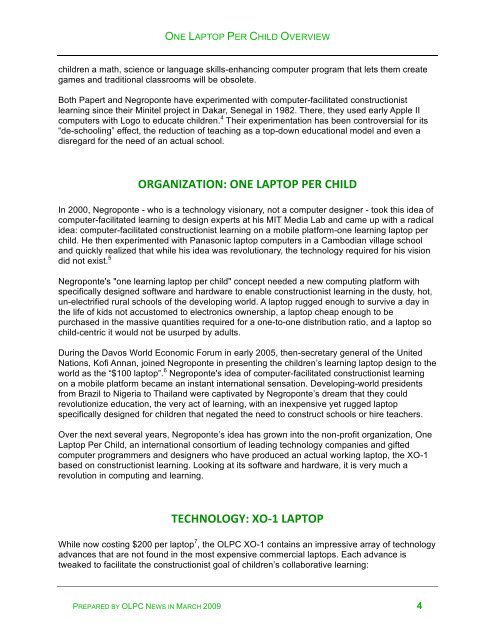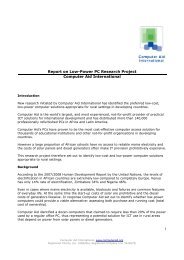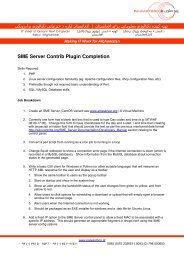ONE LAPTOP PER CHILD OVERVIEW - OLPC News
ONE LAPTOP PER CHILD OVERVIEW - OLPC News
ONE LAPTOP PER CHILD OVERVIEW - OLPC News
You also want an ePaper? Increase the reach of your titles
YUMPU automatically turns print PDFs into web optimized ePapers that Google loves.
<strong>ONE</strong> <strong>LAPTOP</strong> <strong>PER</strong> <strong>CHILD</strong> <strong>OVERVIEW</strong><br />
children a math, science or language skills-enhancing computer program that lets them create<br />
games and traditional classrooms will be obsolete.<br />
Both Papert and Negroponte have experimented with computer-facilitated constructionist<br />
learning since their Minitel project in Dakar, Senegal in 1982. There, they used early Apple II<br />
computers with Logo to educate children. 4 Their experimentation has been controversial for its<br />
“de-schooling” effect, the reduction of teaching as a top-down educational model and even a<br />
disregard for the need of an actual school.<br />
ORGANIZATION:<strong>ONE</strong><strong>LAPTOP</strong><strong>PER</strong><strong>CHILD</strong><br />
In 2000, Negroponte - who is a technology visionary, not a computer designer - took this idea of<br />
computer-facilitated learning to design experts at his MIT Media Lab and came up with a radical<br />
idea: computer-facilitated constructionist learning on a mobile platform-one learning laptop per<br />
child. He then experimented with Panasonic laptop computers in a Cambodian village school<br />
and quickly realized that while his idea was revolutionary, the technology required for his vision<br />
did not exist. 5<br />
Negroponte's "one learning laptop per child" concept needed a new computing platform with<br />
specifically designed software and hardware to enable constructionist learning in the dusty, hot,<br />
un-electrified rural schools of the developing world. A laptop rugged enough to survive a day in<br />
the life of kids not accustomed to electronics ownership, a laptop cheap enough to be<br />
purchased in the massive quantities required for a one-to-one distribution ratio, and a laptop so<br />
child-centric it would not be usurped by adults.<br />
During the Davos World Economic Forum in early 2005, then-secretary general of the United<br />
Nations, Kofi Annan, joined Negroponte in presenting the children’s learning laptop design to the<br />
world as the “$100 laptop”. 6 Negroponte's idea of computer-facilitated constructionist learning<br />
on a mobile platform became an instant international sensation. Developing-world presidents<br />
from Brazil to Nigeria to Thailand were captivated by Negroponte’s dream that they could<br />
revolutionize education, the very act of learning, with an inexpensive yet rugged laptop<br />
specifically designed for children that negated the need to construct schools or hire teachers.<br />
Over the next several years, Negroponte’s idea has grown into the non-profit organization, One<br />
Laptop Per Child, an international consortium of leading technology companies and gifted<br />
computer programmers and designers who have produced an actual working laptop, the XO-1<br />
based on constructionist learning. Looking at its software and hardware, it is very much a<br />
revolution in computing and learning.<br />
TECHNOLOGY:XO‐1<strong>LAPTOP</strong><br />
While now costing $200 per laptop 7 , the <strong>OLPC</strong> XO-1 contains an impressive array of technology<br />
advances that are not found in the most expensive commercial laptops. Each advance is<br />
tweaked to facilitate the constructionist goal of children’s collaborative learning:<br />
PREPARED BY <strong>OLPC</strong> NEWS IN MARCH 2009 4




